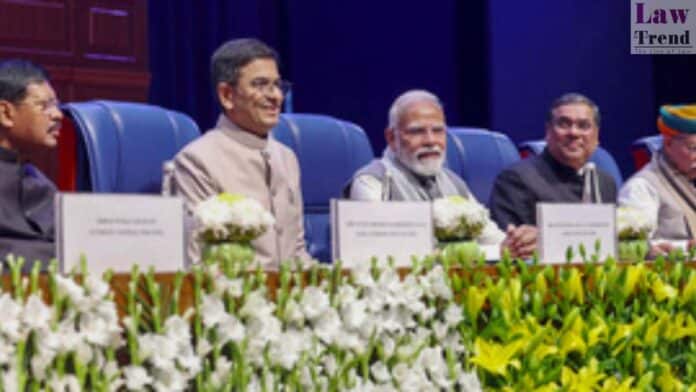The Supreme Court has acted as the Constitution’s heart and soul for the last 74 years by safeguarding the rights of citizens as well as the ideals of justice, liberty, equality and fraternity enshrined in the Preamble, Justice B R Gavai said on Sunday.
The Supreme Court judge was speaking at a function organised by the apex court on the occasion of the inauguration of the Diamond Jubilee Year of its establishment. Prime Minister Narendra Modi was the chief guest for the occasion.
The conception of the Supreme Court also symbolises “the balance of justice”, an institution that will act as a shield for citizens against excesses of power, Justice Gavai said.
Addressing the gathering in which Chief Justice of India (CJI) D Y Chandrachud, top law officers and Law Minister Arjun Ram Meghwal were also present, Justice Sanjiv Khanna said the Supreme Court has prioritised “accessibility” to common citizens while handling the “highest volume of cases” among all its global counterparts.
He, however, flagged that court judgments have “complex articulation” and there was a “rising cost of litigation” which included expenses related to court hearings and the cost due to delay in the form of time and money.
This requires “innovative solutions” such as adoption of technology to make courts citizen-friendly and litigant-driven, said Justice Khanna, who is in-line to become the CJI after Justice Chandrachud’s retirement in November.
Justice Gavai, who will become the CJI after Justice Khanna in May 2025, will be the second Dalit to hold the office after Justice K G Balakrishnan.
Referring to a previous speech of Prime Minister Modi, Justice Khanna said he had “highlighted the importance of drafting laws simply without complicating their understanding”.
“I must acknowledge that complex articulation often seeps into our judgments. Our judgments, though profound and impactful, should be simple, clear and brief,” the judge said.
Justice Khanna said that “while we take pride in the court’s wide accessibility, it is imperative to acknowledge the rising cost of litigation”.
“The two significant financial burdens are the expenses related to court hearings and the cost due to delay in the form of time and money for individuals and businesses, and the taxes for the government,” Justice Khanna said at the function in which other judges of the Supreme Court and chief justices of high courts were also present.
While delivering the vote of thanks, Justice Gavai said in the last 74 years, all the three wings of the State — the legislature, the executive and the judiciary — have worked towards achieving the goals of social, economic and political equality, and also adopted a collaborative approach to ensure that the Supreme Court works at its full strength.
The conception of the Supreme Court symbolises “the balance of justice”, that is an institution that will act as a shield for citizens against the excesses of power, he said and underscored the need for diversity and representation of various sections of society in the judiciary.
“We have been making active efforts to ensure this (diversity), and our efforts shall continue. Since the chief justices of high courts are present here, I would earnestly request them to keep this in mind while making recommendations of elevations for various high courts,” Justice Gavai said.
Justice Khanna said as opposed to earlier days of “larger” benches, currently, Supreme Court benches sit in smaller combinations of two and three judges and it ensures diverse representation within the judicial system.
“Today the court has a strength of 34 judges and pronounces more than 1,000 judgments. This court’s rich history is replete with landmark decisions, echoing the aspirations of our founders. As we look back, let our reflections be more than exercise in nostalgia. Let it be a pledge to fulfil our constitutional responsibilities now and in the foreseeable future,” he said.
In his address, Attorney General R Venkataramani said the recent designation of 11 women lawyers as senior advocates by the Supreme Court was a “significant step” that showed a momentous transition into the world of equality.
“On Republic Day, we saw the demonstration of the commitment of the nation to women empowerment. In a significant step, the Supreme Court, playing its own part, has designated a number of women lawyers as senior counsel. It is not merely symbolic. Steps such as this in the nation, in the legal profession and in the court show a momentous transition into the world of equality,” he said.
“The 74 years of the Supreme Court is a rich treasure house of law and jurisprudence. The history of constitutional litigation in the court shows how it provided a window for ordinary citizens to occupy spaces held by the elite and well endowed,” Venkataramani said.
Justice Gavai also shared the views of the Constitution’s chief architect, Dr B R Ambedkar, who, he said, had stated that Article 32 which deals with the power of judicial review of the Supreme Court was the “very soul” of the Constitution.
Also Read
“The Preamble of the Indian Constitution reflects the ideals of justice, liberty, equality and fraternity, emphasising the commitment to securing justice for citizens. The Supreme Court, as the apex judicial authority, plays the central role in ensuring the realisation of these ideals,” he said.
“Over the last 74 years, the Supreme Court has indeed acted as the heart and soul of the Constitution. Through its judgments, the court has safeguarded the rights of citizens on numerous occasions. Today’s event provides expression to the commitment which the judges have carried in the last 74 years,” he said.
Justice Gavai said he was grateful to CJI Chandrachud for fulfilling the long-standing demand of installing a statue of Ambedkar on the premises of the Supreme Court and giving him the opportunity to play an important role in the project.
“It is only because of Dr Ambedkar and the Constitution, as framed by him and his colleagues, a person like me, who began his schooling in a municipal school situated in a slum area, could reach this position,” he said.







